
Christ Church Burial Ground in Philadelphia is an important early-American cemetery. It is the final resting place of Benjamin Franklin and his wife, Deborah. Four other signers of the Declaration of Independence are buried here, Benjamin Rush, Francis Hopkinson, Joseph Hewes, and George Ross. Two additional signers of the Declaration of Independence, James Wilson and Robert Morris, are buried at Christ Church just a few blocks away.
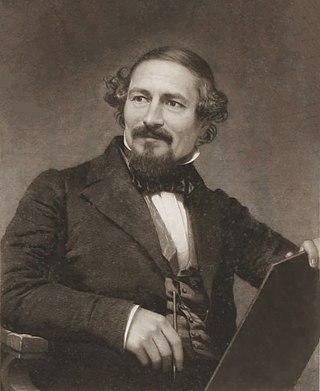
John Sartain was an English-born American artist who pioneered mezzotint engraving in the United States.

Laurel Hill Cemetery, also called Laurel Hill East to distinguish it from the affiliated West Laurel Hill Cemetery in Bala Cynwyd, is a historic rural cemetery in the East Falls neighborhood of Philadelphia. Founded in 1836, it was the second major rural cemetery in the United States after Mount Auburn Cemetery in Boston, Massachusetts.

Evergreen Cemetery – formerly called Citizen's Cemetery and Ever Green Cemetery – is a historic 29.12 acre rural cemetery located just outside Gettysburg Borough, in Cumberland Township, Adams County, Pennsylvania, United States. It is part of Gettysburg Battlefield Historic District, and is surrounded by Gettysburg National Military Park and Soldiers' National Cemetery.

Mount Moriah Cemetery is a historic rural cemetery that spans the border between Southwest Philadelphia and Yeadon, Pennsylvania. It was established in 1855 and is the largest cemetery in Pennsylvania. It is 200 acres in size and contains 150,000 burials. It differed from Philadelphia's other rural cemeteries such as Laurel Hill Cemetery and the Woodlands Cemetery in that it was easily accessible by streetcar; allowed burials of African-Americans, Jews and Muslims; and catered to a more middle-class clientele.

Greenwood Cemetery is a historic cemetery in the Frankford neighborhood of Philadelphia, Pennsylvania, United States. It was established in 1869, is 43 acres in size and contains approximately 20,000 graves.

Paris Cemetery is located along South Main Street in Paris, Kentucky, United States. Incorporated on January 30, 1847, the cemetery is owned and operated by the Paris Cemetery Company. When it first opened, many families re-interred their dead in the new cemetery.

Cedar Hill Cemetery is a historic cemetery in the Frankford neighborhood of Philadelphia, Pennsylvania. It was established by a company incorporated on March 25, 1850. The main gatehouse was built in 1869.

Eden Cemetery is a historic African-American cemetery located in Collingdale, Pennsylvania. It was established June 20, 1902, and is the oldest existing black owned cemetery in the United States. The cemetery covers about 53 acres and contains approximately 93,000 burials.
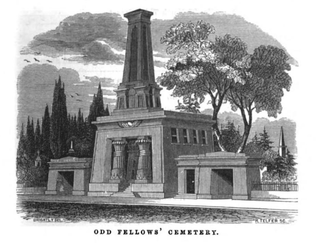
Odd Fellows Cemetery was a 32 acre cemetery located North and South of Diamond Street and between 22nd and 25th Street in the North Philadelphia West neighborhood of Philadelphia, Pennsylvania. It was established in 1849 by the Odd Fellows fraternal organization for the burial of their members. The eighty-one foot high, brown stone, Egyptian Revival gatehouse was designed by architects Stephen Decatur Button and Joseph C. Hoxie.
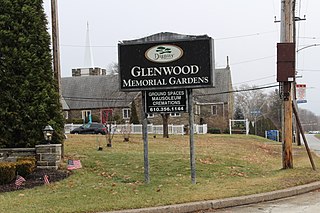
Glenwood Memorial Gardens is a 70-acre lawn cemetery in Broomall, Pennsylvania. It was originally established in 1849 as a rural cemetery on 20 acres in North Philadelphia as Glenwood Cemetery. Over 700 Union and Confederate soldiers who died in local hospitals during the American Civil War were buried in Glenwood cemetery. The soldiers' remains were moved to the Philadelphia National Cemetery in 1891.

Lawnview Memorial Park, also referred to as Lawnview Cemetery, is a cemetery located at 500 Huntingdon Pike in Rockledge, Pennsylvania. It is 82 acres (33 ha) in size and is managed by the Odd Fellows Cemetery Company of Philadelphia. It contains the reburial of tens of thousands of bodies from Monument Cemetery and the Odd Fellows Cemetery in Philadelphia after they were closed in the 1950s.
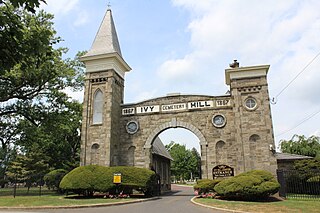
Ivy Hill Cemetery is a public cemetery and crematorium located at 1201 Easton Road in the Cedarbrook neighborhood of Philadelphia, Pennsylvania. Chartered in 1867, it is 80 acres in size and was originally named the Germantown and Chestnut Hill Cemetery. It was renamed Ivy Hill Cemetery in June 1871.
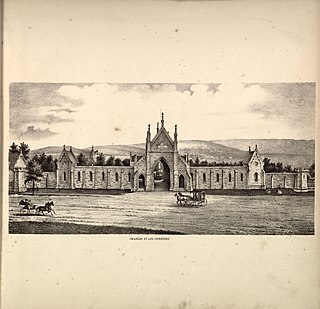
Charles Evans Cemetery is an historic, nonsectarian, garden-style cemetery located in the city of Reading, Pennsylvania. It was founded by Charles Evans (1768-1847), a son of Quaker parents and native of Philadelphia who became a prominent attorney and philanthropist in Reading during the late 18th and early 19th centuries.
Lebanon Cemetery was an African-American cemetery in Philadelphia, Pennsylvania established in 1849. It was one of only two private African-American cemeteries in Philadelphia at the time. Lebanon Cemetery was condemned in 1899. The bodies were reinterred in 1902 to Eden Cemetery in Collingdale, Pennsylvania and the cemetery was closed in 1903.

Mount Vernon Cemetery is a historic rural cemetery located at 3499 West Lehigh Avenue in the East Falls neighborhood of Philadelphia, Pennsylvania. It was established in 1856, is 27 acres in size and contains over 18,000 graves. It was neglected for decades by an absentee landlord. No plots have been sold since 1968, it was not open to the public, many graves fell into disrepair and the cemetery became heavily overgrown. In 2021, a Philadelphia judge ordered the cemetery be placed in conservatorship due to neglect.

The Jewish cemetery in Oświęcim, Poland, was destroyed by the Germans during World War II and partly restored by returning Jewish survivors after the Holocaust. In Communist Poland it fell into disrepair and was fully restored in the 1990s.

Lafayette Cemetery was a cemetery in the Passyunk Square neighborhood of Philadelphia, Pennsylvania. It was established in 1828 and originally intended for 14,000 burials but over time fell into disrepair and became overcrowded with 47,000 burials. In 1946, the cemetery was condemned by the city of Philadelphia. The bodies were disinterred in 1947, transported to the Evergreen Memorial Park in Bensalem, Pennsylvania, and reinterred in a mass grave.






















